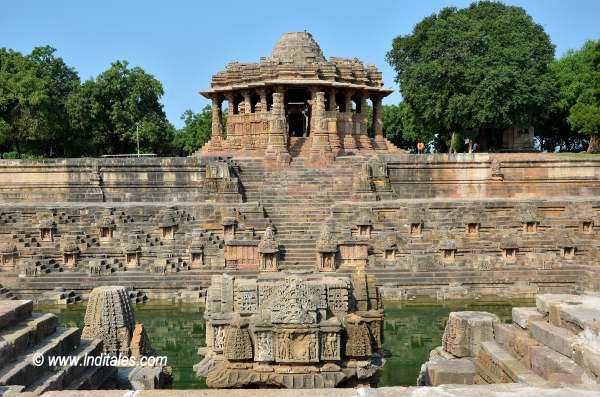
There are two prominent Sun temples in India. One is Konark on the east coast in the state of Odisha. And the other in the western state of Gujarat at Modhera. In this post, I am going to explain the architecture of Sun Temple Modhera that was built in 1026 CE by King Bhimdev – a Solanki King who ruled from Patan. Solankis are a Suryavanshi dynasty. Descendants of Sun and hence a temple dedicated to Sun. This temple is a contemporary of Chola temples in South and Chandela temples in North. This was the peak of Indian temple architecture with ample examples across the country of finest sculpted architecture.
Modhera Sun Temple
If I were to close my eyes and go back in time, I would like to go back to early 11th CE when the country would be full of lovely temples with painted walls and artists still working on giving the finishing touches to their masterpieces. When in ruins they look so enthralling. How would they be when they were all practicing temples with music and dance a part of their daily rituals? One can only imagine. Let’s look at what is left with us after Mahmud Ghazni & Allaudin Khilji’s generals tried their best to destroy the Sun temple at Modhera.
Architecture of Sun Temple Modhera explained
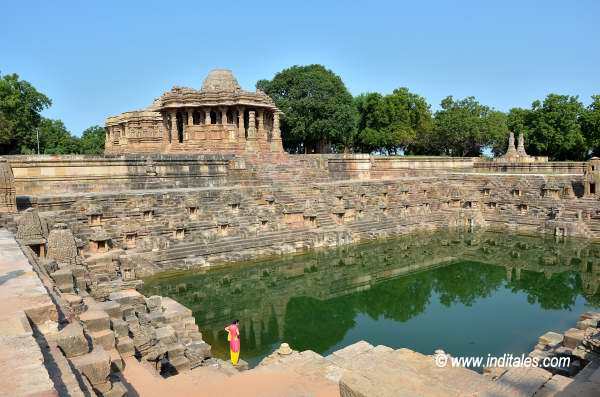
Let me explain the Architecture of Sun Temple Modhera. Modhera Sun temple has 3 main parts. The main temple with a Garbhagriha and a mandapa called Guda Mandapa, a detached Sabhamandapa, and a stepped water tank. When the temple reflects in the waters of the tank it looks mesmerizing. It’s reigning deity – the Sun helps enhance the beauty at its magic hours in the morning and evening. Just behind the temple, the river Pushpavati flows. You can see some Keerti Torans on the side of the temple. It is not a practicing temple as there is no idol left in the temple.
The temple is built using the locking system that is said to be an earthquake resistant method. As in the case of an earthquake; the structure would shake but not fall. It also sits on the tropic of cancer that passes through India. I am yet to figure out the significance of building a temple right on the tropic of cancer. Awe is the first expression you would have when you first look at the temple. I went around the temple a couple of times and then hired a guide who then explained the nuances.
Surya Kund at Sun temple Modhera
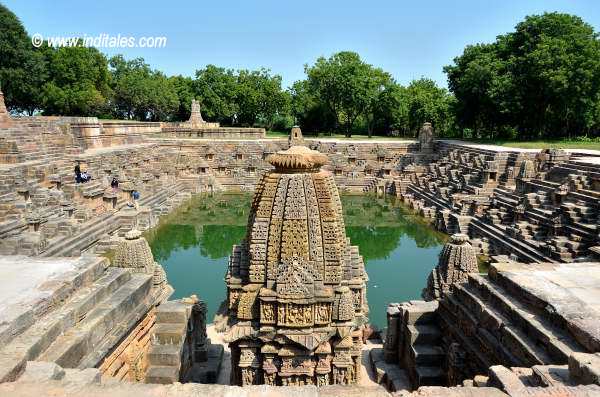
The water tank or Surya Kund at Modhera’s Sun temple is a stepwell on the eastern edge of Sun temple complex facing the Sabha Mandapa. It has pyramid shaped steps forming some intriguing geometric patterns on the steps. However what makes this tank distinct from other similar temple tanks is the presence of big and small temples on its steps. On the step directly opposite the temple, a temple has Vishnu on Shesh Shaiya. There are temples dedicated to Ganesha and Shiva as Nataraja. One temple is dedicated to Shitlamata – the goddess of Chicken Pox, whose vehicle is a donkey and she holds broom in one hand and Neem leaves in another. Other temples are in various states of ruins, but they all look beautiful even now.
It is said that originally there were 108 shrines on these steps. It is difficult to count how many of them remain, but they are just simply beautiful. The geometry of the formations is breathtaking.
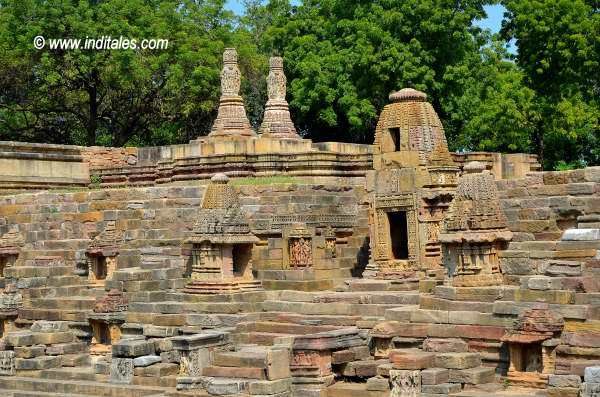
According to literature, the steps of Surya Kund are a stylized mirror image of the Shikhara that unfortunately no longer exists. Symbolically it brought together the fire and the water.
Turtles still live in the waters of this tank. This tank is also called Ramakund for the legend of Rama associated with the place.
Sabhamandapa at Sun Temple, Modhera
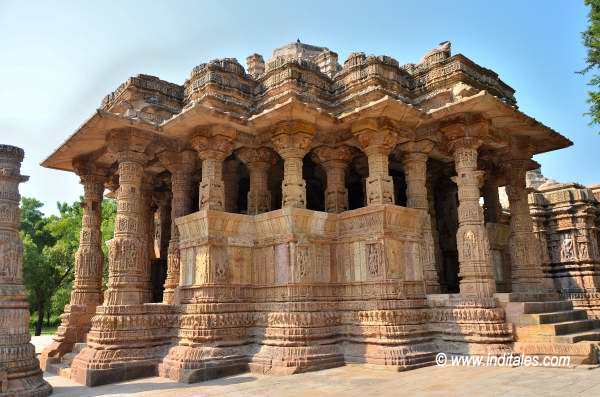
Sabhamandapa is a diagonally arranged octagonal hall that welcomes you with its exquisite toran. Its best feature is it’s magnificently carved pillars carrying Torana arches in alternate triangular and semi-circular designs. Literature tells me there are 52 pillars denoting the 52 weeks of a solar year. The heavily carved pillars have scenes from Ramayana, Mahabharata & Krishna Leela. Some of the scenes that I remember is Sita in Ashok Vatika in Sri Lanka, Vanar Sena with stones in their hands to make the bridge, Krishna with Govardhan Parvat on his fingertip and Arjuna with his bow in Draupadi’s Swayamvar. There are Vishkanya’s doing their makeup.
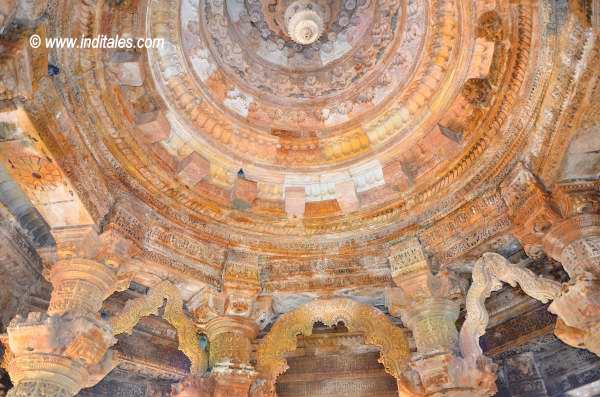
This hall was used for public functions – religious or otherwise like councils, performances or public meetings.
Main Modhera Sun Temple
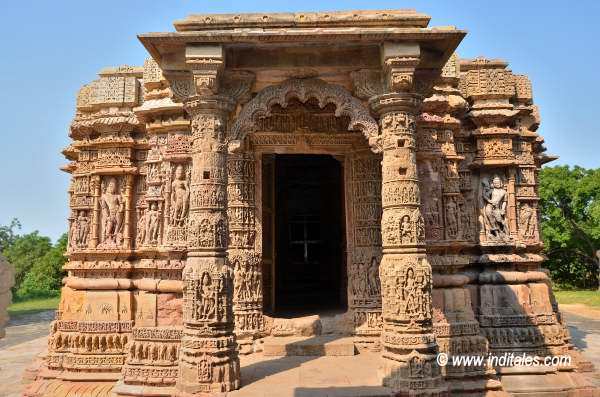
The Sun temple is so designed that on the days of equinoxes i.e. 21st March and 21st September, the first rays of sun fall on the idol of Sun in Garbhagriha. Is this not an engineering wonder too then? The main sun temple is on a plinth that is designed like an inverted lotus. Remember lotus is a flower that responds to the sun rays and lives only for the time sun rays are there. On top of lotus petals is a panel carved with Elephants called Gaj-Petika. Above these the entire life cycle of a human being is carved; starting right from the time a human being is conceived with an act of intercourse to the death depicted with last rites. There are other erotic figures as well on the exterior as was the norm in the temples of that era.
There are sculptures of people playing various musical instruments. Above these flora/fauna/life are deities. There are 12 idols of Parvati in her various forms called Dwadash Gauri. There are 12 idols of Sun as if he is all pervading. Some idols of Sun are in Irani Style with Gumboots and a long cap. As per the guide, this is because the sun worship started in Iran.
Deities of 8 directions
8 directions of the temple have deities of the 8 directions:
- North – Kubera, the lord of wealth
- North-East – Rudra – a form of Shiva
- East – Indra or lord of Rains
- South-East – Agni or lord of Fire
- South – Yama, God of death
- South-West – Nairiti – a form of Shiva
- West – Varun or lord of water
- North-West – Vayu or Lord of Air
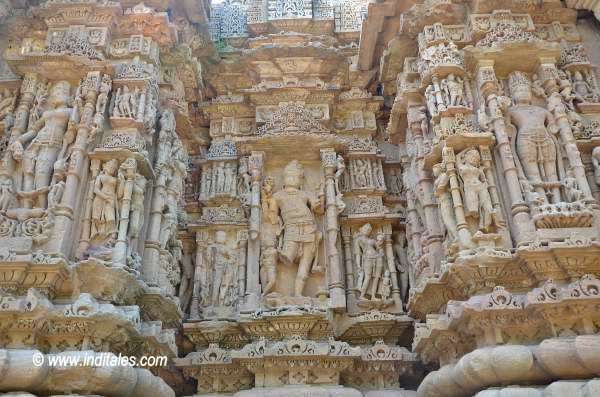
Plundering
It is said that the main idol was made of pure gold and depicted sun sitting on his chariot with 7 horses with his Sarathi Arun driving the chariot. The idol sat on a deep plinth that was again filled with gold coins. Today, all you can see is the deep pit in Garbhagriha that tells the tale of plundering. It is said that the diamonds on the idol could lit the whole temple. All this is oral history and no one knows where the idol is. Some say that when the attacks were made on the temples, some Brahmin families hid the idols with them and saved it. Based on what I read and heard, whereabouts of this idol are not known. There is a closed underground path that potentially links the temple to Patan, the capital city of Solankis.
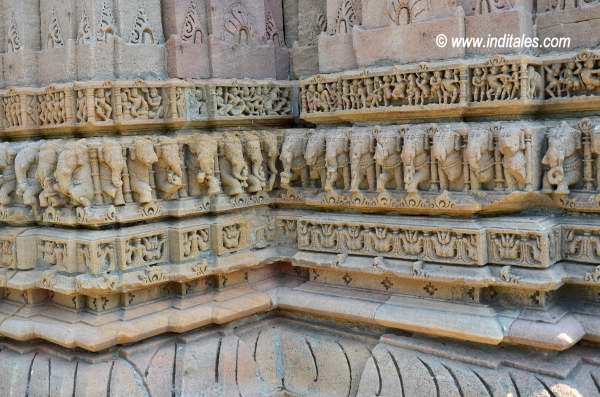
Garbhagriha has a circumambulation path and is attached to an octagonal Guda mandapa. Guda mandapa is embellished with niche images of twelve Aditya’s – showing different aspects of the Sun – probably representing each Solar month.
The Shikhara or the superstructure is missing so the temple now looks flatter than it should be.
Legend of Modhera Sun Temple
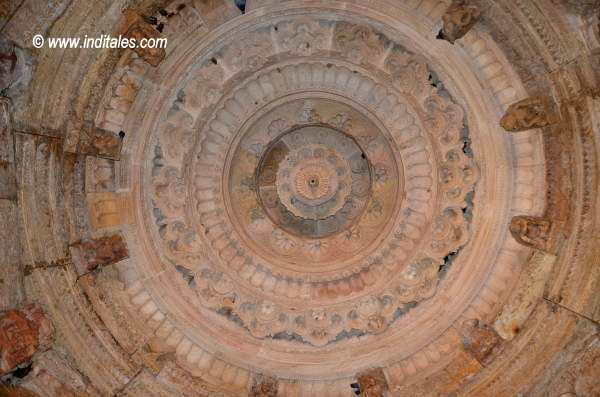
According to Skanda Purana and Brahma Purana, it is said that when Ram was coming back from Sri Lanka after killing Ravana, he wanted to do absolve himself of the sin of killing a Brahmin – remember Ravana was a Brahmin. He asked Vashishth Muni to show him a place where he can do the same and the sage pointed him to Dharmaranya – or the forest of the Dharma. Rama performed his Yagna here and established a village called Sitapur. Sitapur is the village that came to be known as Modhera later, which actually translates to a mound of the dead, probably because this place has seen layers of civilization, one upon the other. Another legend says this Modhera got its name from Modh community of Brahmins who helped Rama perform his yagna here.
Sun temple at Modhera is one of the few archeological sites that are very well maintained by ASI. Do put it on your itinerary when you go to Gujarat. Hope this blog helps you better understand the Architecture of Sun Temple Modhera.
Recommend you to read following travel blog on Places to visit in Gujarat.
- Mysterious Mahakali temple, pavagadh hill , Gujrat, UNESCO world heritage site.
- Legacy of a Queen – Rani Ki Vav.
- 6 Must see Museums in Ahmedabad.
- Explore Medieval Architecture at Champaner.
- Carved Gates of Dabhoi.



0 Comments